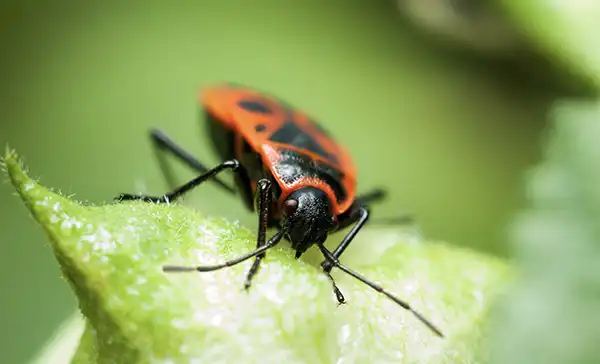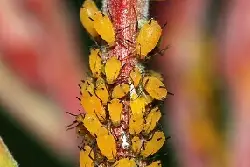Utah Tree Pests
Utah Tree Pests: What You Need to Know (And How We Handle Them)
Utah’s full of tree pests. Utah’s most common tree pests include various defoliators like tent caterpillars and Douglas-fir tussock moths, as well as borers such as Asian longhorned beetles and bark beetles
You don’t need to be a plant expert to know something’s wrong when your tree starts looking sick, dropping leaves early, or getting sticky. A lot of these pests don’t just “go away on their own.” Some will outright kill your tree if you don’t deal with them. We’ve seen it happen too many times.
At Diamond Tree Experts, we’ve been dealing with plant health care for over 57 years. We know what pests show up in which parts of Utah, when to treat, and how not to waste your time or money.
Why Addressing Utah Tree Pests Matter
You ignore pests, your tree declines. It’s that simple. Some pests kill slowly – they stress the tree over time. Others get inside the bark or roots and take the whole thing down before summer’s over. Either way, the longer you wait, the fewer options we have to save it.
People usually don’t call us until the tree is yellow, thinning out, or dropping branches. And by then, it’s a toss-up if we can fix it.
That’s why we offer pest inspection, diagnosis, and treatment plans. No guesswork. No spraying random stuff. Just practical steps based on what we see on your property.
Most Common Tree Pests in Utah (and What We Do About Them)
Aphids
They feed on sap, cause curled leaves, and leave a sticky mess that turns black with mold. You’ve probably seen it and just didn’t know what it was.
- When to watch: Spring through fall
- How we help: We inspect the infestation, determine the right spray timing, and apply insecticidal soap or horticultural oil without harming beneficial insects.
Elm Leaf Beetles
Elm trees get torn up fast. These beetles chew through leaf tissue like it’s their job (because it is).
- When to watch: Late spring and summer
- How we help: We offer early-season systemic treatments and spray programs when activity is high. We time it right—before major damage hits.
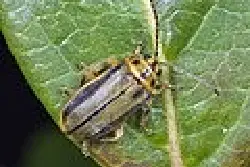
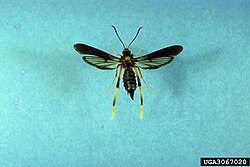
Borers (Lilac-Ash, Flatheaded, etc.)
The worst offenders. Once they’re inside the tree, it gets ugly fast. If you’ve got ash or birch trees, this should already be on your radar.
- When to watch: Spring and early summer
- How we help: We focus on prevention. Systemic insecticides timed early in the season give your tree a fighting chance. If borers are already active, we inspect and tell you what’s realistic—treatment or removal.
Scale Insects
They look like growths on branches but suck the life out of the tree. People mistake them for bark texture until branches start dying back.
- When to watch: Spring and summer
- How we help: We use dormant oil sprays in winter and growth regulators in spring. We check for crawler stages—because that’s when they’re vulnerable. Timing is everything here, and we know the windows.
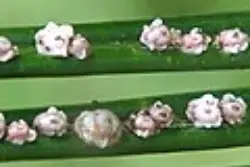
Utah Tree Pest Management Calendar
By Diamond Tree Experts
Serving Utah’s trees since 1967
| Season | What to Watch | What to Do | How We Help |
|---|---|---|---|
| Late Winter (Feb–Mar) | Dormant scale, overwintering aphids/mite eggs, early canker signs | Dormant oil spray, inspect bark, prune infected limbs | Apply dormant oil, prune while trees are dormant, early inspections |
| Spring (Apr–May) | Aphids, elm leaf beetles, tent caterpillars, cankerworms, pine weevil | Bt sprays, soap for aphids, remove tents, systemic insecticides, sticky bands | Timed treatments, ID pests early, control before damage gets bad |
| Summer (Jun–Aug) | Spider mites, Ips beetles, borers, scale crawlers, tent moths, Cytospora | Mite control, deep water trees, borer sprays, treat scale, prune cankers | Treat active pests, monitor stress signs, respond fast to visible issues |
| Fall (Sept–Oct) | Boxelder bugs, late aphids, overwintering pests, cankerworm eggs, pine moth signs | Boxelder treatment, cankerworm bands, plan removals, fall fertilization | Prep trees for winter, treat nuisance pests, honest tree assessments |
| Winter (Nov–Jan) | Past damage, dormant scale, borer/canker issues, structural weak points | Tree removal, winter pruning, dormant oil, structural inspections | Safe removals, dormant care, prep next year’s strategy, expert evaluations |
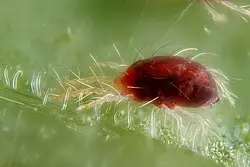
Spider Mites
Dry, hot conditions in July and August? Expect mites—especially on evergreens and spruce. If needles are bronzing and dropping, you’re probably already behind.
- When to watch: Mid to late summer
- How we help: We’ll inspect first. Water pressure sprays can do a lot. If it’s a big infestation, we use targeted miticides. No broad-spectrum overkill.
Tent Caterpillars
You’ve probably seen them—big webby nests in the forks of tree branches in spring. Those are tent caterpillars. The actual caterpillars come out and chew through leaves fast. They don’t kill mature trees outright, but they strip leaves clean and stress younger trees pretty hard.
- When to watch: Early to mid-spring
- How we help: We remove nests manually when possible (early is best), then treat with a targeted product like Bacillus thuringiensis (Bt). Safe for other wildlife. Timing matters—before the tents get huge.
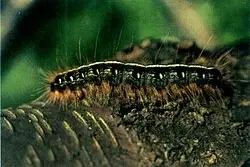
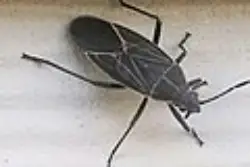
Boxelder Bugs
They’re mostly a nuisance, but if you’ve got boxelder trees, maples, or ashes nearby, they show up in numbers. They don’t do much leaf damage, but they cluster in warm spots, leave droppings, and attract other issues. Homeowners usually complain once they’re crawling on siding or windows.
- When to watch: Fall (they’re looking for a place to overwinter)
- How we help: We reduce their numbers with low-toxicity perimeter treatments and recommend pruning female boxelders if they’re a chronic problem.
Cankerworms (Spring and Fall)
These are leaf chewers—small green or brown caterpillars that dangle on silk threads and strip foliage. Trees can usually survive one year of damage, but repeated infestations will weaken them. You’ll see lots of little holes in leaves or leaves completely missing.
- When to watch: Spring and fall
- How we help: Sticky banding in fall helps catch adults before they lay eggs. In spring, we inspect and apply safe biological controls (like Bt) before they get out of hand.
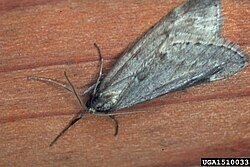
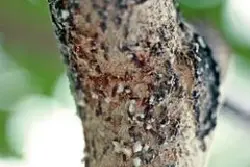
Oystershell Scale
Hard to spot unless you’re looking for it. These insects form a brown, crusty shell that looks like bark—blends right in. But they’re sucking sap and damaging twigs the whole time. Big populations can kill entire branches on aspens, ash, and maples.
- When to watch: Spring and early summer (look for “crawlers”)
- How we help: Dormant oil sprays in late winter kill overwintering insects. In spring, we use insect growth regulators or systemic insecticides if the infestation is bad.
Poplar Borer
If you’ve got cottonwoods or poplars, these are worth knowing about. The larvae bore into trunks and create rough, oozing patches where they enter. They don’t work fast—but they weaken the structure of the tree over time and open the door to fungal infections.
- When to watch: Summer
- How we help: We inspect the trunk for entry holes and frass (sawdust-looking debris), then treat preventatively with a trunk injection if needed. We also check for general stress—because healthy trees resist borers better.
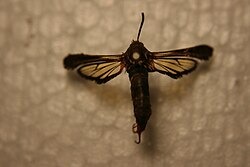
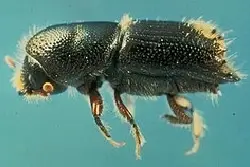
Ips Beetles (Engraver Beetles)
Mostly hit pines and spruce. These beetles bore under the bark and disrupt how the tree moves water and nutrients. You don’t usually see them—just dying limbs, fading needles, and sawdust near branch collars. Once the beetles are in deep, it’s hard to stop.
- When to watch: Spring through fall, especially after windstorms or drought
- How we help: We inspect for entry holes and pitch tubes. If caught early, we use preventative trunk sprays or systemic injections. If it’s too far gone, we recommend removal to stop it from spreading to nearby trees.
White Pine Weevil
This one targets the tops of spruce and pine trees—especially Colorado blue spruce. Larvae burrow down from the terminal leader (very top of the tree), which kills the leader and messes up the tree’s form permanently.
- When to watch: Spring
- How we help: We look for wilting or curling at the top early in the season. We remove infested leaders before larvae move down, then apply systemic insecticide at the base for prevention.
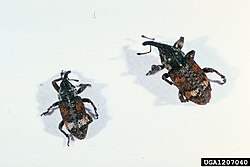
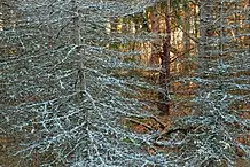
Cytospora Canker (Not a bug, but still a pest)
Fungal disease that takes advantage of stressed spruce and aspen trees. Starts as sunken, dead-looking areas on branches. Later, you’ll see resin oozing out or whole limbs browning and dying. It spreads slowly but steadily.
- When to watch: Late spring through fall
- How we help: We prune infected limbs, clean up deadwood, and improve airflow. No silver bullet spray here—it’s about sanitation, moisture control, and long-term care. We tell you what’s worth saving and what’s not.
Western Tent Moth
Different from tent caterpillars, but similar mess. They spin webbed nests and feed in groups. Mostly hit chokecherry, crabapple, and other ornamentals. Defoliation looks dramatic, but rarely fatal if caught early.
- When to watch: Late spring
- How we help: Manual nest removal when young, followed by a biological spray (Bt) timed while larvae are still feeding. We’ll also check nearby trees to stop it from spreading.
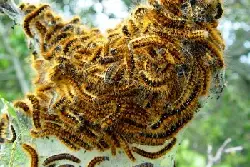
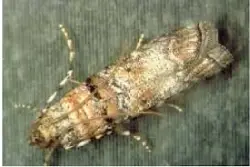
Zimmerman Pine Moth
If you’ve got Austrian or Scotch pine, this one matters. Larvae burrow into branch crotches and cause pitch to ooze out in globs. Over time, it weakens the tree structurally. Branches snap in the wind. Trees become disfigured and ugly.
- When to watch: Late summer (damage shows), early spring (to treat)
- How we help: We target larvae before they hatch using a spring insecticide. If damage is visible, we evaluate structure and remove risky limbs. Prevention works best, especially on stressed or overplanted pines.
What Happens If You Do Nothing With Your Utah Tree Pests
You end up calling us for tree removal.
It starts with yellowing leaves or tip dieback, then whole limbs go. Borers get into the trunk. Fungal infections follow. You blink and a mature tree is collapsing into your driveway.
The fix is never cheaper later. That’s why we tell people: if you think something’s wrong, don’t wait. Just get it checked. We offer no-obligation inspections for this reason exactly.
Common Mistakes We See When Dealing With Utah Tree Pests
- Spraying the wrong chemical at the wrong time
- Killing beneficial bugs while trying to kill the bad ones
- Pruning too much while the tree’s already stressed
- Thinking mulch or fertilizer is the solution (it’s not)
- Not calling anyone until it’s already half-dead
What Diamond Tree Experts Actually Does
We don’t just spray and leave. Here’s how we handle pest problems:
- On-Site Inspection
We send a certified arborist to walk the property. We don’t guess—we look at leaves, bark, soil, root flare, and tree structure. - Diagnosis
We tell you exactly what pest(s) you’re dealing with. Could be multiple. Could be something else entirely—like nutrient stress or disease. We don’t assume. - Treatment Plan
Some problems need immediate treatment. Others just need monitoring. We give you options. We also help you avoid wasting money on one-size-fits-all sprays. - Preventative Care
We also do annual pest prevention plans—especially helpful for neighborhoods with a lot of maples, elms, or ash. Keep problems from starting in the first place.
Let Diamond Tree Experts Help with Your Utah Tree Pests
Utah tree pests don’t take summers off. Some years are worse than others. But every year, we see preventable damage that costs people trees, money, and time.
If you think something looks off, give us a call. We’ve been doing this since 1967. We’ve seen every pest and every mistake. We know how to fix things when they’re fixable—and when they’re not, we know how to fix the issue.
We offer free quotes, reasonable pricing and can help you keep your trees healthy for years to come.
